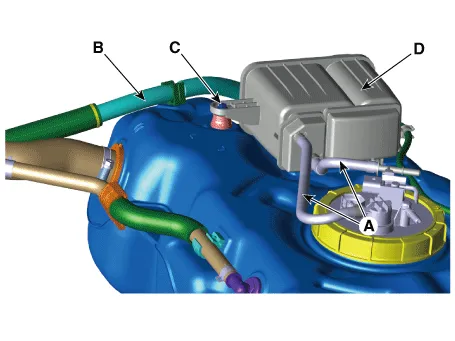Kia Picanto (JA): Evaporative Emission Control System / Canister
Repair procedures
| Removal |
| 1. | Turn the ignition switch OFF and disconnect the battery negative (-) terminal. |
| 2. | Remove the fuel tank assembly.
(Refer to Fuel System - "Fuel Tank")
|
| 3. | Disconnect the vapor (A) and ventilation hose (B). |
| 4. | Remove the mounting bolt (C) and then remove the canister (D).
|
| Installation |
| 1. | Install in the reverse order of removal. |
| Inspection |
| 1. | Check for the following items visually.
A: Canister ↔ Fuel Tank B: Canister ↔ Intake Manifold C: Canister ↔ Atmosphere |
Description and operation Description Evaporative Emission Control System prevents fuel vapor stored in fuel tank from vaporizing into the atmosphere.
Specifications Specification Item Specification Coil Resistance (Ω) 18.
Other information:
Kia Picanto (JA) 2017-2026 Service & Repair Manual: Hazard Lamp Switch
Repair procedures Inspection 1.Check for continuity between terminals. If the continuity is not as specified, replace the hazard lamp switch. No. Description No.
Kia Picanto (JA) 2017-2026 Service & Repair Manual: Heating,Ventilation, Air Conditioning
Specifications Specification Air conditioner Item Specification Compressor Type 5VSe09(Variable Dispacement Swashplate) 5VS09 Oil type & Capacity FD46XG(PAG) 100±10g Pulley type POLY V RIBBED BEIT 6PK Displacement 90cc/rev Condenser Heat rejection 9,890 -3% kcal/h
Categories
- Manuals Home
- Kia Picanto Owners Manual
- Kia Picanto Service Manual
- Coolant
- Fuel Delivery System
- General Information
- New on site
- Most important about car


